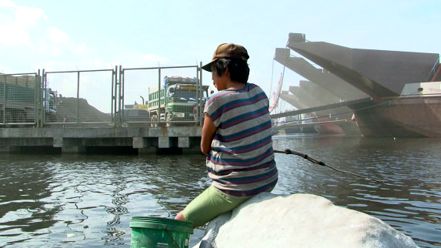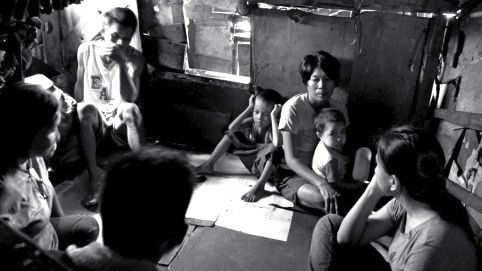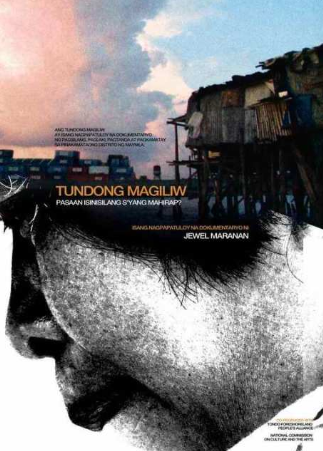SUMMARY
This is AI generated summarization, which may have errors. For context, always refer to the full article.

MANILA, Philippines – I watched some documentaries featured in SONA: TOTAL in UP Diliman. All films portrayed the country’s current situation; hence it’s something students like me ought to watch before President Benigno Aquino III gives his third State of the Nation Address (SONA) on July 23.
Tundong Magiliw (Tondo, Beloved) by Filipina filmmaker Jewel Maranan felt closest to me.
The filmmaker followed the everyday life of a family living in a make-shift house standing amidst the polluted waters of “happyland,” Tondo. Behind its simplicity and slow pace is a story of one urban poor Filipino family which reflects the lives of many others experiencing similar struggles.
There was no narration all-throughout the film; it wasn’t necessary. The images and daily conversations of the family already said a lot.
Shots were raw and simple, giving us a truthful and unexaggerated view of the Tondo life.
The story
Virgie is pregnant with her 4th child. She stays in the house, cooks, cleans and takes care of her children. She also goes outside to fish and to look for scraps of wood which she chops and uses for cooking. Her husband is almost never seen in the house except during mealtimes. We assume that he is out working. Her 3 children are Jope, Loloy and Inday.
Jope, being the eldest, is given more tasks: he fishes, cooks, does errands (mostly to buy snacks and sodas outside) and looks after his siblings. Meanwhile, Loloy and Inday are both too young to participate in such tasks. We see them play and swim in the dirty waters at which their home stands; also from which they get their fish to eat, and where others throw their waste.
Later on in the film, it’s the same water where fishes die.
Most of the film takes place in their small house — most of the family’s activities are done in their small floor space: it’s where they cook, eat and sleep. And later on in the film, it is also the same floor space where Virgie gives birth to her 4th child. We are not sure if this will be her final child.
I also observed that there seems to be a small age difference between Loloy and Inday. And now Virgie has a new baby while her daughter Inday is barely a baby herself.
The RH Bill connection
As an audience, I was left to assume that Virgie and her husband do not make use of family planning methods — or perhaps it was their choice to have many children.
But given their current situation, I was hoping that they would opt to limit the number of their children or at least plan a bigger birth space between their kids. Now, the small floor space of their tiny home will be even more crowded with the addition of kid number 4. And who knows how many more kids might follow?
Virgie’s family situation reminds me of the debates concerning the RH Bill. The Catholic Church strongly opposes the passing of this bill.
I do not understand why a bill which aims to help, protect, assist and educate families and individuals is contested. Why would we hinder the passing of a bill which would help save the lives of many women and children? Contraception does not equate to abortion; it is an entirely different issue in itself.
Reproductive health education does not equate to the promotion of promiscuity. The RH bill aims to provide access to appropriate information, services and resources so as to help in family planning and reproductive health management.
I do not see anything wrong with this bill; I am left to wonder what kind of evil it is said to bring. I see no evil in providing women their rights to reproductive health care.

The family that eats together…
Virgie awaits the day that she gives birth. In the meantime, she attends to her “motherly duties.” She manages to feed her family of 5 despite their financial constraints.
Throughout the film, we always see the family eating together. Together they sit on the floor and pass around plastic bowls — we see them having rice and instant noodles for dinner, fish that Jope caught for lunch, and some rice and viand stored inside a plastic bag that the father brought home. Every meal, we would hear the kids say “Akin yan, akin yan! (That’s mine! That’s mine!)”
We find out from Virgie that Jope doesn’t have a birth certificate, one of the reasons why he is not currently enrolled in school. Before they moved to Tondo, Jope studied until Grade 2. Upon arriving in Tondo, none of the children seem to be going to school anymore. What would become of these children?
Hence the question of the filmmaker: to what are poor children born to?
The K-12 program connection
This reminds me of the issue of the K-12 education program which was already approved by the Aquino administration.
I have no qualms about trying to improve the state of education and trying to be at the same level as other countries. But I wish the government had taken more time to examine the current state of Philippine education and its budget before they drastically made this decision.
The existing 10-year curriculum is already very problematic to begin with: the lack of schools and classrooms, books, resources, facilities and teachers. There is an obvious lack of budget to sustain and improve the already existing 10-year curriculum.
And here we see the government add an additional two years — without even fixing its existing problems and budget constraints.
I wish the added budget was used to further improve the quality of education and to provide what is lacking.
The problem to be fixed here is not the quantity, not the number of years at school, but the quality of education.
In recent studies, it is said that the Philippine Math and Science education fares very poorly; actually, the same can be said for our education system in general.
Now, how will Virgie’s kids receive a good education?
The risks they take
There are no shortcut solutions. I think most of the country’s leaders, as well as some of its people, are not aware or are afraid of embracing this fact.
At the end of the film, we see Virgie talking to an old woman. The old woman assists women in their community in giving birth.
One evening, after dinner, the old woman stays at Virgie’s home. She caresses Virgie’s belly and says that Virgie’s baby is a girl because of her sleeping position. The old woman also explained the signs if it was a baby boy. Virgie’s husband agrees with the old woman’s explanation of the baby’s presumed sex.
Such superstitions and traditional ways of thinking become prevalent in the absence of proper reproductive health education.
The old woman slept in their house that night. Virgie, her husband, their 3 kids and the old woman all slept side by side in the small floor space. They had no electricity, just candles and a paper fan.
The next morning, the old woman spread out some shirts on the small floor space where Virgie would give birth. She prepared a bowl of water with some cloth dipped in it, and she wore a glove on one hand while her other bare hand rested on Virgie’s leg. Virgie’s husband sat beside her and yelled at their kids playing outside, “Sarado niyo yung pinto! (Close the door!)”
During this scene, all I can think of was how many more Filipinas have to undergo this unsafe and unsanitary procedure of giving birth? How many more mothers and babies die or go untreated after such risky procedures?
Moments later, Virgie gives birth to a baby girl.
And their family life continues.
Perhaps this cycle will also continue, not just for Virgie and her family, but for many other Filipino families in Tondo and everywhere else in the Philippines.

I will watch the SONA on July 23, but I hope that the rest of the President’s audience will not forget the realities which may or may not be mentioned in the President’s much-anticipated speech. – Rappler.com
Add a comment
How does this make you feel?
There are no comments yet. Add your comment to start the conversation.